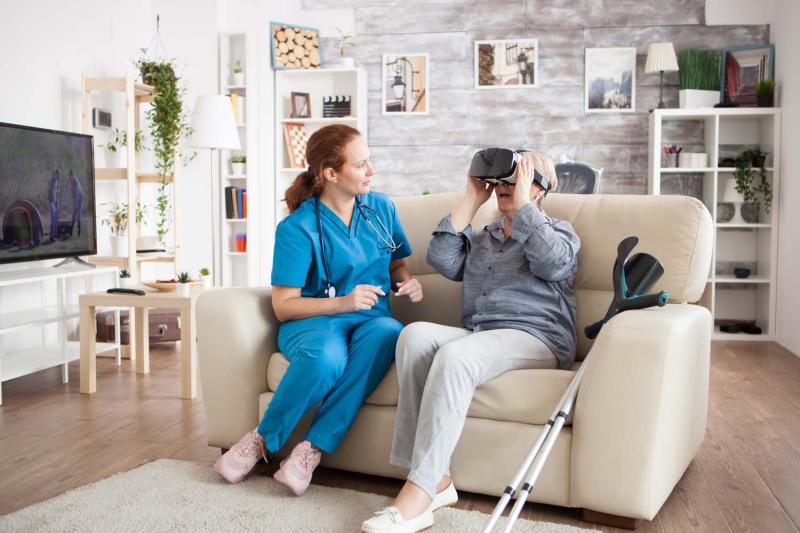Key points
- With technological advancements, it is important that aged care staff have the knowledge and confidence to get the most out of workplace technology.
- Most studies in our scoping review highlighted the importance of staff training when implementing technology into aged care.
- Multiple studies acknowledged the importance of a supportive workplace environment when familiarising staff with new technology.
- Providing ongoing staff training was identified as important for the workforce to keep up with ongoing technology updates and staff turnover.
With technological advancements, it is important that staff have the knowledge and confidence to get the most out of workplace technology. There are many types of technology in aged care, requiring different levels of staff involvement, for example, telehealth appointments, electronic health records, and robots. Technology training is important for aged care staff to maintain compliance with regulations, work more efficiently, provide high-quality care, and gain confidence in using the technology.
The training provided for Certificate III-qualified workers (most of the Australian aged care workforce) does not include digital literacy training. [1] Therefore, staff working in the aged care sector are likely to have differing levels of digital literacy skills. [2] In general, staff who are older, speak English as a second language or have little experience with technology, are more hesitant toward technology. [3] However, providing appropriate training to staff can help to overcome these barriers. [4] Staff who are trained in digital technology are also more likely to accept new technologies, [1] and more readily assist in their implementation. [5] This may be due to staff understanding more about both the purpose of the technology and how to operate it effectively. [1] Aged care organisations need to ensure that their workforce have sufficient levels of digital literacy to keep up with technological advancements and to provide quality care. [1]
This evidence theme summarises one of the key issues we identified as part of a scoping review of research on human factors and technology in aged care. We identified seven studies on this topic [3, 6-11]. If you need more information on this topic, try using the PubMed searches below.
Some studies in our scoping review focused on how important staff believe training is when introducing new technology into aged care. One study reported that residential aged care facilities that provided staff training were more likely to increase their technology use over time. [10] Staff also valued appropriate training in new technologies. In one study, staff spoke about wishing to receive technical training that would enable them to use newly implemented technologies. However, staff also expressed interest in learning about the scope of the technology (i.e., what it is expected to do, and what it cannot do), how they could use technology to support older people, and how to maintain the technology. Some aged care workers wanted to know more about managing any risks associated with technology, such as potential malfunctions. [9]
Multiple studies suggested a supportive workplace environment is crucial when training staff to use technology. Study participants reported feeling competent in using new technology when they had help and support from others (e.g., management, mentors, champions, or trainers). [3, 6, 7, 11] One study stated that an important component in successful technology uptake among staff is feelings of self-efficacy (confidence in their own abilities). In the context of technology training and aged care, self-efficacy is more likely to occur if staff get opportunities to gain experience in using the technology (e.g., from training and practice) or if they can learn from or alongside others. [8] This might include peers, champions, facilitators, managers, or co-workers.
Some studies focused on potential barriers to staff technology training. A consistently reported issue was that when not all members of staff participated the training, this could make implementation more difficult and time-consuming. [3] This may be due to high staff turnover rates or the difficulties in releasing some staff from caring duties to attend training. In addition, some aged care staff reported not being given additional training when system updates came into place. [3] These findings suggest that staff benefit when technology training is seen as an ongoing process that involves new and existing staff over time.
Overall, the evidence about staff technology training in aged care is relatively limited. However, service providers may want to consider:
- Implementing new technology gradually over time, using a stepwise approach
- Being aware that technology training may be overwhelming for some staff and putting extra supports into place for them [2]
- Celebrating staff accomplishments [6]
- Providing personalised feedback to staff about their learning [11]
- Putting extra administrative support in place to enable staff to focus on learning and becoming confident with the technology without additional time pressure [11]
- Providing ongoing training for new staff and updating trained staff on any changes to the system [3]
- Providing data entry templates for staff to follow. [6]
This evidence theme has been informed by the results of a scoping review intended to map the published research in this area. Our findings reflect the current state of the evidence which we note is limited in breadth and quality.
- Aged Care Industry Information Technology Council. A technology roadmap for the Australian aged care sector [Internet]. Australia, ACIITC; 2017. [cited 2023 Feb 21]. Available from: http://aciitc.com.au/wp-content/uploads/2017/06/ACIITC_TechnologyRoadmap_2017.pdf.
- Banbury A, Taylor ML, Gray LC, Reid N, Smith AC. Sustaining and expanding telehealth activity: Training requirements for Australian residential aged care front-line staff. PEC Innovation. 2023;2:100109.
- Vuorinen M. Registered nurses’ experiences with, and feelings and attitudes towards, the International Resident Assessment Instrument for long-term care facilities in New Zealand in 2017. J Res Nurs. 2020;25(2):141-55.
- Mettler T, Vimarlund V. All that glitters is not gold: Six steps before selecting and prioritizing e-Health services. J Med Syst. 2017;41(10):154.
- Moyle W, Pu L, Murfield J, Sung B, Sriram D, Liddle J, et al. Consumer and provider perspectives on technologies used within aged care: An Australian qualitative needs assessment survey. J Appl Gerontol. 2022;41(12):2557-65.
- Garnett A, Connelly D, Yous M-L, Hung L, Snobelen N, Hay M, et al. Nurse-led virtual delivery of PIECES in Canadian long-term care homes to support the care of older adults experiencing responsive behaviors during COVID-19: Qualitative descriptive study. JMIR Nurs. 2022;5(1):e42731.
- Karsan Y, Anderson C, Boyd MJ, Thornley T. Exploring barriers to the sustainability of an electronic administration system in long-term care facilities: A case study approach. Res Social Adm Pharm. 2021;17(6):1066-71.
- Newbould L, Ariss S, Mountain G, Hawley MS. Exploring factors that affect the uptake and sustainability of videoconferencing for healthcare provision for older adults in care homes: A realist evaluation. BMC Med Inform Decis Mak. 2021;21(1):13.
- Papadopoulos I, Ali S, Papadopoulos C, Castro N, Faulkes N, Koulouglioti C. A qualitative exploration of care homes workers' views and training needs in relation to the use of socially assistive humanoid robots in their workplace. Int J Older People Nurs. 2022;17(3):1-9.
- Powell KR, Winkler AE, Liu J, Alexander GL. A mixed-methods analysis of telehealth implementation in nursing homes amidst the COVID-19 pandemic. J Am Geriatr Soc. 2022;70(12):3493-502.
- Qi Tan AJ, Chua WL, McKenna L, Chin Tan LL, Lim YJ, Liaw SY. Enablers and barriers to nurse-facilitated geriatric teleconsultations in nursing homes: A qualitative descriptive multi-site study. Age Ageing. 2022;51(12).
Connect to PubMed evidence
This PubMed topic search is focused on research conducted in aged care settings (i.e., home care and residential aged care). You can choose to view all citations or free full-text articles.


